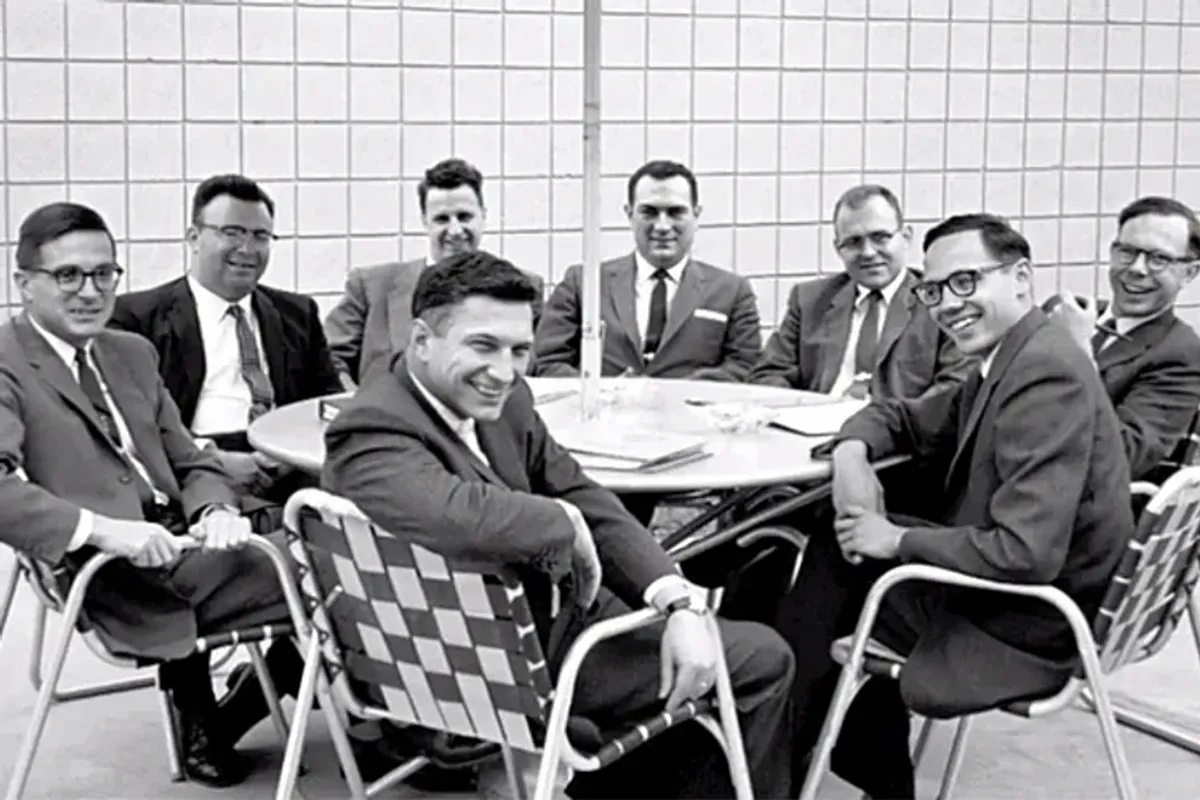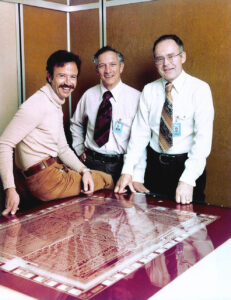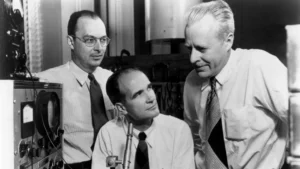Introduction
In the mid-1950s, a group of brilliant young scientists found themselves working under the shadow of a dominating figure, Dr. William Shockley, at Shockley Semiconductors. It marked a significant milestone as the inaugural high-tech enterprise in the region that would eventually be recognized as Silicon Valley, focusing on the advancement of silicon-based semiconductor devices.
Read More::Follow us on LinkedIn for all major updates
William Shockley
William Shockley (1910–1989) was an American physicist and inventor who made significant contributions to the field of electronics, particularly in the development of the transistor. He is best known for co-inventing the transistor, a revolutionary electronic component that played a crucial role in the advancement of modern technology.
Little did they know that their journey of frustration and ambition would lay the foundation for what we now know as the Silicon Valley.
The story of the Traitorous Eight is a tale of resilience, innovation, and the birth of Fairchild Semiconductor, a company that would change the face of the semiconductor industry and pave the way for the tech revolution.
The Shockley Semiconductors Era: Micro Management and Tensions
In 1956, the Shockley Semiconductor Laboratory commenced its operations in a modest commercial space located in the vicinity of Mountain View.
In the initial stages, Dr. Shockley aimed to recruit former colleagues from Bell Labs, although their reluctance to relocate from the bustling eastern high-tech research hub hindered these efforts.
Consequently, he brought together a group of emerging scientists and engineers, a few from different departments within Bell Laboratories.
Their collective objective was to conceive a novel crystal-growth mechanism capable of yielding single-crystal silicon boules—a challenging feat considering the formidable melting point of silicon.
Research
While the research on transistors was ongoing, Shockley conceived the notion of utilizing a four-layer device (in contrast to the usual three-layer structure of transistors) with a distinctive ability to autonomously switch between the “on” and “off” states without requiring additional control inputs.
Traditional circuits demanded multiple transistors—typically three—for similar functionalities. Hence, for intricate switching networks, the new diodes promised to significantly reduce complexity.
This innovative component came to be known as the Shockley diode.
Dr. Shockley grew increasingly convinced of the immense significance of this novel device, believing it could rival the importance of the transistor itself. Intriguingly, he chose to keep the entire project veiled in secrecy, even within his own company.
This approach led to progressively paranoid behavior on his part.
In a well-known incident, he became convinced that a secretary’s minor finger injury was part of a plot against him, leading him to order lie detector tests for all company personnel.
Shockley’s management style also fluctuated, contributing to a tumultuous atmosphere. At times, he prioritized the immediate production of basic transistors, while intermittently downplaying the Shockley diode project in pursuit of a “perfect” production system. This inconsistency caused discontent among the employees, leading to minor uprisings within the company.
Read more: The Fall of Intel: How an MBA CEO’s Short-Term Thinking Destroyed a Semiconductor Giant
The Decision to Part Ways: The Birth of Fairchild Semiconductor
During the 1950s, acquiring specialized knowledge about semiconductors was notably challenging. Within the realm of William Shockley’s supervision, researchers faced a plethora of difficulties. These challenges encompassed micro-management, impatience, and skepticism. Shockley’s own fear of internal rebellion went to such lengths that he initiated detective-led inquiries and even contemplated the use of lie detector tests.
Moreover, Shockley’s competence as a businessman was severely questioned by his employees. His strained relationship with key investor Arnold Beckman and his frequent outbursts were sources of growing tension.
Future
The considerable research expenses incurred due to Shockley’s habit of jumping between projects also cast a shadow on the company’s future.
The environment prevailing within the confines of Shockley Semiconductor was rife with contempt, stress, and stifling conditions.
This pressure-cooker atmosphere seemed poised to implode at any given moment. Little did anyone know that the aftermath of this turmoil would pave the way for what would become the most influential group of technology pioneers from the late 1950s onwards.
The Summit at the Redwood Room: Seeds of Revolution
By 1957, the mounting frustrations had reached a breaking point. A pivotal meeting took place in the Redwood Room of the Clift Hotel, where eight young scientists convened to discuss their exit from Shockley Semiconductor and the formation of their own venture, with MIT graduate Robert Noyce as their leader.
This gathering of brilliant minds, with members aged between 26 and 33, marked the initial stride in constructing a company that would go on to serve as the origin of over 2,000 subsequent spin-out tech companies.
The composition of this group seemed almost tailor-made for success. Among them, six held PhDs. Noyce was a distinguished semiconductor researcher, while Grinich boasted a deep understanding of electronics.
Hoerni contributed both scientific acumen and strong managerial expertise. Despite variations in experience levels, their collective academic background and time spent under Shockley’s mentorship offered great promise.
Their shared dissatisfaction, unified vision, and youthful enthusiasm coalesced, compelling them to break away from Shockley and establish their own enterprise.
Early struggle
A significant hurdle faced by the eight visionaries was garnering support from others. Geography emerged as a formidable obstacle in their quest for financial backers, as the western coastal location had limited access to bankers and investors predominantly concentrated on the east coast.
The geographical disparity complicated the conduct of meetings and negotiations.
Finally, the group managed to connect with seasoned bankers from Boston, Arthur Rock and Bud Coyle, who lent their expertise to aid in attracting investors. However, this endeavor took place in an era where venture capitalists, as we recognize them today, were largely absent.
Rock and Coyle tirelessly approached more than 30 potential companies before a breakthrough emerged with Fairchild Camera and Instrument.
Sherman Fairchild, the namesake of the company, extended a critical lifeline—a $1.4 million loan alongside a $3 million buyout option.
This infusion of resources marked the inception of Fairchild Semiconductor, an entity that would go on to revolutionize the semiconductor industry and reshape the landscape of electrical engineering in the times that followed.
Noyce’s semiconductor expertise, Moore’s engineering prowess, Hoerni’s managerial skills, and Grinich’s electronics knowledge, along with the collective training under Shockley, became the driving force for their future endeavor
Birth of Fairchild Semiconductor: A Paradigm Shift
Once they secured office space, the group took a significant stride toward formalizing their business. Fairchild’s next move involved recruiting a diverse workforce from the Santa Clara Valley, including individuals experienced in the region’s canning industry.
This marked a departure from the small and intimate group that had originally established operations in Grinich’s home garage.
The fledgling startup quickly gained momentum. Teams efficiently established their own workspaces and focused on essential components. Their tasks ranged from winding diffusion tubes and cultivating silicon crystals to devising manufacturing processes almost from scratch.
The invaluable support from figures like Hoerni, who developed the planar process, and Kleiner, who played an administrative role, contributed greatly to the rapid breakthroughs achieved by Fairchild.
It was from these efforts that Fairchild Semiconductor made its most monumental contribution to the history of engineering: the integrated circuit (IC). While Texas Instruments shares credit for co-discovering this innovation, Fairchild’s planar process was the key to unlocking mass production.
This process involved etching all the necessary components—transistors, capacitors, and resistors—onto a single unified surface. This breakthrough not only led to significantly higher production yields but also set a precedent for the entire industry. The labor-intensive practice of crafting individual components gave way to more efficient batch production.
However, while the global semiconductor community celebrated this advancement, not everyone shared the enthusiasm for Fairchild’s progress. Driven by a sense of betrayal and a rivalry with his former colleagues, William Shockley labeled the group the “traitorous eight.”
Tensions escalated due to the physical proximity of Fairchild’s location, merely 12 blocks away from Shockley’s facility. At the time, the neighboring towns of Palo Alto and Mountain View were still relatively underdeveloped, which amplified the impact of the competing tech players vying for local talent.
Proximity, Rivalry, and Decline: The Tale of Shockley Semiconductor and the ‘Traitorous Eight'”
Moreover, Shockley Semiconductor never managed to recover following the departure of the eight scientists. Shockley’s subsequent creation, the four-layer diode, achieved technical success but failed to gain commercial viability in the face of the rapid advancements of integrated circuits.
Despite a series of smaller accomplishments, Shockley Semiconductor Laboratory was eventually acquired by Clevite Transistor in 1960.
Changing the Game: Fairchild’s Legacy
While Shockley Semiconductor holds the distinction of being the technical pioneer of Silicon Valley, Fairchild’s influence vastly outweighs its counterparts.
As the original source of numerous core technologies now in widespread use, the company served as a pivotal springboard for employees eager to explore new horizons.
Fairchild’s legacy, along with the multitude of subsequent “Fairchildren,” has indelibly left its mark on Silicon Valley and extended beyond. Renowned names like Intel, AMD, Xilinx, Altera, LSI Logic, and National Semiconductor trace their origins to this lineage.
The mentorship of Noyce initiated a cascade effect, shaping the trajectories of luminaries such as Steve Jobs, Sergey Brin, and Larry Page, and contributing to the founding narratives of Apple and Google.
Traitorous Eight’: Icons of Innovation and Industry Pioneers
Despite the provocative moniker associated with the “traitorous eight,” these individuals have earned a commendable reputation within the industry. Their members have branched into teaching, consulting, entrepreneurship, and even the establishment of prominent venture capital firms.
Notably, Kleiner’s funding played a pivotal role in the initial successes of various tech companies, including Amazon. Gordon Moore, a father of Moore’s Law and one of the quartet still living, maintained senior positions at Intel until 1997, when he assumed the title of Chairman Emeritus. He also founded a philanthropic foundation alongside his wife.
Grinich transitioned into academia, authoring the first textbook on integrated circuits. He further ventured into creating companies specializing in RFID tags.
Blank embarked on the journey of founding financial firm Xicor, while Hoerni established several enterprises, including Amelco (subsequently acquired by Microchip) and Intersil (acquired by Renesas). Last, Roberts and Kleiner joined forces with Hoerni at Amelco.
Despite the “traitorous eight” label, the remaining members have come to terms with their unconventional nickname.
They even attempted to reconcile with Shockley, albeit with limited success. Over the course of their lives, their collective contributions to engineering have elevated them to legendary stature among their peers and contemporaries.



